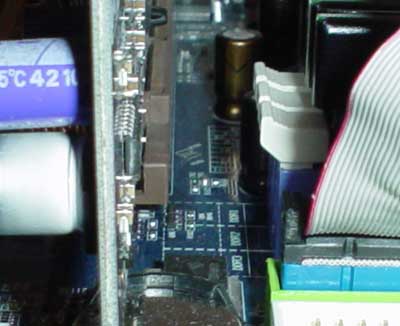
Original Link: https://www.anandtech.com/show/1007
Gigabyte 7VAXP (KT400): Breathing Some Life Back into KT400
by Evan Lieb on October 3, 2002 12:30 PM EST- Posted in
- Motherboards
After reviewing Gigabyte's SiS 648-based 8SG667 motherboard about two weeks ago, we were very pleased to see how well Gigabyte implemented DDR400 support. We had no trouble running 3 sticks of CAS2 Corsair DDR400 memory in all 3 DIMM slots at aggressive timings. And of course, we saw some modest performance gains utilizing maxed DDR400.
It seems as if Gigabyte has done a similarly good job with the Gigabyte 7VAXP. Using an as of yet unreleased BIOS, the 7VAXP's prospects with DDR400 still aren't anything too exciting or stellar, but we can at least proclaim this time around that this memory type actually does work quite well with this motherboard. We'll take a look at this aspect of the 7VAXP in the coming pages.
Read on to see how Gigabyte has tweaked the KT400 chipset and how you will reap the benefits of their hard work…
|
Motherboard Specifications |
|
|
CPU
Interface
|
Socket-462
|
|
Chipset
|
VIA
KT400 North Bridge
VIA VT8235 South Bridge |
|
Bus
Speeds
|
133
- 165MHz in 1MHz increments (166MHz-200MHz via DIP switches)
|
|
Core
Voltages Supported
|
up
to 1.925V (in 2.5%/5% increments)
|
|
I/O
Voltages Supported
|
N/A
|
|
DRAM
Voltages Supported
|
up
to 2.8V in 0.1V increments
|
|
Memory
Slots
|
3
184-pin DDR DIMM Slots
|
|
Expansion
Slots
|
1
AGP 8X Slot
5 PCI Slots |
|
Onboard
RAID
|
Promise
PDC20276
|
|
Onboard
USB 2.0/IEEE-1394
|
USB2
Supported through South Bridge
VIA VT6306 IEEE-1394 Firewire Controller |
|
Onboard
LAN
|
Realtek
8100BL
|
|
Onboard
Audio
|
Realtek
ALC650 6-channel audio
|
Gigabyte 7VAXP: Basic Features
Gigabyte threw together some really solid features for the 7VAXP motherboard.

We start off by examining the Promise PDC20276 RAID controller that comes with the 7VAXP. This is a very standard RAID chip, supporting RAID 0 (striping) and RAID 1 (mirroring) arrays. This chip also supports up to the unofficial ATA133 transfer rate. Unlike other onboard RAID chips we've seen (like the HighPoint's HPT374 RAID controller that supports up to 8 IDE devices), the PDC20276 supports 2 channels for support of up to 4 IDE devices.
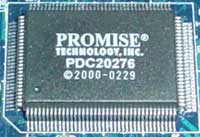 |
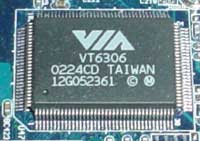 |
The addition of an onboard Firewire chip (VIA VT6306) is always something we like to see included with a motherboard. Even more important is the fact that the 7VAXP has three Firewire headers for you to use, although that's a bit excessive considering the VT6306 chip limits you to no more than 3 Firewire ports total. However, it's always nice to see more options, isn't it? The vast majority of motherboards are now coming with USB 2.0 support, and the Gigabyte 7VAXP natively supports USB 2.0 through the VIA VT8235 South Bridge. This offers support for up to 6 USB ports. Besides the two rear USB ports present on the 7VAXP, you also have two USB headers located at the bottom of the motherboard if you feel the desire to expand the rear I/O options.
Sound and LAN are powered by Realtek chips, dubbed the ALC650 and 8100BL.
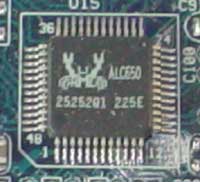 |
 |
There's nothing special about either chip; the ALC650 is a conventional 6-channel AC'97 sound chip. The 8100BL is a good old fashioned 10/100 NIC, except it's an onboard chip and not a separate PCI card obviously. We had no trouble setting up either LAN or sound during our testing.
As usual, Gigabyte's Dual BIOS is present on the motherboard:
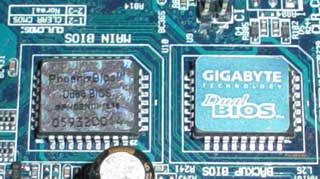
As the name implies, Dual BIOS refers to two physical BIOS chips mounted on the board itself; should one get corrupted or improperly flashed, you can default to the remaining BIOS in order to recover from an otherwise certain disaster. The feature is fairly cheap to implement and results in much lower RMA rates for user caused problems (more specifically, incorrectly flashing your BIOS).
Just like Soyo did with their KT400 Dragon Ultra, Gigabyte went with active cooling on the KT400 North Bridge:
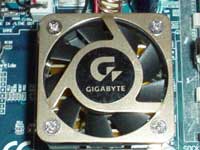
As we mentioned in previous KT400 reviews, active cooling isn't the greatest idea if you desire an absolutely silent system with no chance of North Bridge fan failure (OEMs especially don't usually like lots of moving parts, active North Bridge fans included). We would like to see Gigabyte take more of an ASUS approach and opt for a larger passive heatsink rather than a smaller heatsink with a fan mounted on it.
There's plenty of room for expansion on this motherboard, with 5 PCI slots available. You're also capable of fitting in as much as 4.0GB of memory in any of the 3 available DIMM slots if you desire to do so.
One of the somewhat more noticeable features of this motherboard is support for up DDR400 memory. In our previous three KT400 reviews, it has been made quite clear that DDR400 brings absolutely no extra performance to the Athlon XP platform just yet. This holds true for the Gigabyte 7VAXP for the most part, but, as you'll see in our benchmarks shortly, there's actually a little bit of a performance boost. Skip to the "Stress Testing" section for more information regarding DDR333 and DDR400 compatibility, performance, and stability/reliability information.
Board Layout
Gigabyte did a terrific job with the 7VAXP motherboard layout.
As we always like to mention, the placement of the ATX (20-pin) connector is an important layout feature. Gigabyte positions the ATX connector towards the top of the motherboard above the DIMM slots this time. Gigabyte fulfills this promise for the most part by placing the ATX connector towards the top of the motherboard, just to the right of the DIMM slots. For the size and shape of the motherboard, this is about where the ATX connector should be placed, as it'll give the user a lot more room to maneuver inside the case mitigating the hassle with having to deal with all the ATX lines.
Yet another good layout decision on Gigabyte's part is the amount of space left between the DIMM connectors and the AGP slot. There's ample room between the two so that you don't have to uninstall your video card to uninstall memory. We've always preached this as an important aspect of a motherboard's layout, and this motherboard is no exception.
The CPU lever was fairly easy to unlatch with this board (unlike the Soyo KT400 Ultra). There were no capacitors or fan headers impeding the unlatching of the lever or installation of the CPU. Unfortunately, Swifttech and Alpha users will be turned off by the fact that Gigabyte yet again decides to skip the inclusion of four mounting holes for cooling. We wonder why Gigabyte continues to "forget" this feature, as good cooling is important for Athlon users, especially tweakers and overclockers.
BIOS Setup and Overclocking Features
The Gigabyte 7VAXP is yet another KT400 motherboard that utilizes the Award BIOS setup that we've become so accustomed to lately. Gigabyte added some very interesting features BIOS options and features to this motherboard, so let's check them out, shall we?
We were able to toy with DRAM timing options a fair amount with the Gigabyte 7VAXP. As you can tell by looking at the home BIOS page however, there is no Advanced Chipset Features section, which is almost always where the DRAM timing options are located. However, you can bring up the Advanced Chipset Features option in the BIOS by simply holding the CTRL key and pressing F1; voila, you get all the DRAM timing options you could want. Gigabyte tells us that they are just experimenting with their high-performance BIOSes at the moment, and so that's the reason why we have to go through the whole CTRL + F1 procedure. This feature is documented in the manual though, so it's not a hidden feature. Also, the DRAM options available in Advanced Chipset Features include an adjustable CAS Latency, memory timing mode, bank interleave, Precharge to Active, Active to Precharge, Active to CMD, Burst Length, Queue Depth, and Command Rate.

If you backtrack a bit to our Gigabyte 8SG667 (SiS 648) review once more, you'll notice that there were no DRAM timing options available via the latest BIOS. This, unfortunately, still holds true to this day, despite the CTRL F1 feature being fully operational on the Gigabyte 7VAXP. However, the Gigabyte 8IEXP motherboard (gold winner of our 845E roundup) supports this hidden CTRL F1 DRAM timing feature, so those users might be happy.
The PC Health section remains unchanged from most of the other Award BIOS PC Health sections (except the Gigabyte 8SG667) we've used before. You get a whole array of readings including PSU readings and CPU Vcore readings.
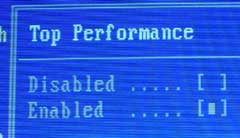
Another very interesting aspect of the internal 7VAXP M9.F5 BIOS that was finalized 6 days ago (and is going through validation as we speak for public release next week) is the Top Performance option in the BIOS. Top Performance is disabled by default in the M9.F5 BIOS as well as the F5 BIOS available on Gigabyte's web site. When we enabled top performance in the M9.F5 BIOS however, we saw an average of 8-10% increase in performance with all other DRAM and frequency settings equal to the other KT333 and KT400 solutions.
When we asked Gigabyte how this Top Performance option was able to increase performance this much, their explanation was pretty simple. Essentially, Top Performance optimizes the memory controller in the North Bridge for the best performance possible but at a stable enough state. So enabling Top Performance doesn't change any memory or frequency settings, it simply speeds up the internal timings of the memory controller. It would be interesting to see an option in the BIOS of a future Gigabyte motherboard that contained lots of memory controller tweaking options.
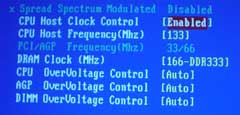
Finally, we take a look at the overclocking "features" the 7VAXP offers; unfortunately, there are hardly any convenient overclocking options. Besides the voltage tweaks available (which are pretty good for the most part, considering you can adjust AGP, Vcore, and VDIMM with slack), there are no intriguing overclocking features. The maximum attainable FSB through the 7VAXP's BIOS goes only as high as 165MHz, or if you enable the DIP switches, 166MHz-200MHz. In addition, there are no PCI divider or multiplier adjustment options in the BIOS. The board itself does contain jumpers that would allow multiplier options to be turned on, but nothing too flexible. Overclockers should be turned off by this point, which is somewhat of a disappointment since Gigabyte was actually becoming more enthusiast/overclocking friendly for a while.
Stress Testing the Gigabyte 7VAXP
Like we have done with the ASUS A7V8X, ECS L7VTA, and Soyo KT400 Ultra, the Gigabyte 7VAXP had to go through some massive DDR333 and DDR400 testing before we could truly dub this the "fastest" Socket A motherboard on the market. Luckily, Gigabyte did an exceptional job tweaking the 7VAXP for DDR333 AND DDR400 performance versus the other KT400 motherboards we've seen on the market.
Here are the memory timings we were able to run with DDR333 filled in all memory
banks running Prime95 for 48 hours straight. We also ran our benchmark suite
for several hours to make absolutely sure the 7VAXP was stable at these settings:
|
Stable
DDR333 Timings |
|
|
Clock
Speed:
|
166MHz
|
|
Timing
Mode:
|
Turbo
|
|
CAS
Latency:
|
2
|
|
Bank
Interleave:
|
4-bank
|
|
Precharge
to Active:
|
2T
|
|
Active
to Precharge:
|
5T
|
|
Active
to CMD:
|
2T
|
|
Command
Rate:
|
1T
|
The Gigabyte 7VAXP tied with the Soyo KT400 Ultra for the best DDR333 timings
we've ever been able to achieve using Corsair CL2 DDR400 memory. There's an
option for Ultra DRAM timing mode, but that was not stable enough for our liking.
Our DDR333 performance results for the Gigabyte 7VAXP and Soyo KT400 Ultra motherboard
lead us to believe that KT400 boards are marginally faster than VIA's previous
Socket A chipset, the KT333.
DDR400 was equally impressive for the most part. With all banks filled, we only
had trouble running at the most aggressive timings possible (i.e. similar to
DDR333 settings). Once we backed off the timings however, we were able to run
DDR400 with all banks filled operating at the following settings:
|
Stable
DDR400 Timings |
|
|
Clock
Speed:
|
200MHz
|
|
Timing
Mode:
|
Normal
|
|
CAS
Latency:
|
2.5
|
|
Bank
Interleave:
|
2-bank
|
|
Precharge
to Active:
|
3T
|
|
Active
to Precharge:
|
5T
|
|
Active
to CMD:
|
3T
|
|
Command
Rate:
|
1T
|
These settings aren't stellar, but in all reality they aren't that bad either, as the fastest timings compared to the ones above won't increase performance noticeably anyway. You will see a performance drop due to the lowered bank interleave and Precharge to Active/Active to CMD settings, but it won't be more than 10%, which is the point at which a performance delta is noticeable in real world applications. We should also note that this is the only KT400 motherboard that can run DDR400 with all banks filled, and so therefore we were quite satisfied with our results, despite the tiny performance boost the DDR400 afforded.
Manufacturer Tech Support and RMA
With this review we are introducing a new addition to our individual motherboard reviews here on AnandTech - Manufacturer Tech Support & RMA. These sections will talk about a motherboard manufacturer's Technical Support and RMA processes.
The way it works is first we anonymously email the manufacturer's tech support address(es), obviously not using our AnandTech mail server to avoid any sort of preferential treatment. Our emails (we can and will send more than one just to make sure we're not getting the staff on an "off" day) all contain fixable problems that we've had with our motherboard. We then give the manufacturer up to 72 hours to respond over business days and will report not only whether they even responded within the time allotted but also if they were successful in fixing our problems. If we do eventually receive a response after the review is published, we will go back and amend the review with the total time it took for the manufacturer to respond to our requests. The idea here is to encourage manufacturers to improve their technical support as well as provide new criteria to base your motherboard purchasing decisions upon; with motherboards looking more and more alike every day, we have to help separate the boys from the men in as many ways as possible. As usual, we're interested in your feedback on this and other parts of our reviews so please do email us with your comments.
As far as Gigabyte's technical support is concerned, it wasn't exactly stellar, as we failed to get an answer back from their tech support within 72 hours. Initially, we had to send the email again as we had supposedly made a mistake in filling out Gigabyte's technical support form, which consists of listing your entire setup (CPU, memory, manufacturer, etc.). Gigabyte's technical support form is quite long and cumbersome, but we think it's a very good idea to dealing with a customer's technical issues, as it makes it easier for Gigabyte to pinpoint the exact cause of the problem and provide a more meaningful solution. The fact that we didn't receive a response in 72 hours is very disappointing, hopefully this won't continue with future attempts to contact Gigabyte using our new technical support evaluation procedure for other motherboard reviews.
The RMA section of our motherboard reviews is similar to the process we went through at technical support. The goal here is to figure out how painless (or painful) RMAing a dead motherboard is. As many of you will know, to "RMA" (Return Merchandise Authorization) a product means to ship a dead product back to the manufacturer (or vendor) and receive a working product in return; this all depends on the warranty policy of the manufacturer and how it applies to your product as well as the manufacturer's RMA policy. Some manufacturers will force you to RMA your board through your vendor, while others will go as far as to ship you a new board before you even send out your dead one.
How did Gigabyte handle our RMA test? Gigabyte responded to our email within 24 hours (much better than their tech support response rate) with the following automated message:
|
This policy isn't too bad, as some motherboard manufacturers leave it completely up to the vendor to deal with RMA and sometimes even technical support problems. But it's entirely up to you to deal with your vendor initially to obtain an RMA before you can contact Gigabyte regarding it.
The Test
|
Performance Test Configuration |
||
| Processor(s): |
AMD Athlon
XP 2000+
|
|
| RAM: |
256MB Samsung DDR333 CAS2.5 module (M368L3223CTL-C (L) B3)
256MB Mushkin DDR400 CAS2.5 module 256MB Corsair DDR400 CAS2 module |
|
| Hard Drive(s): |
Western Digital 120GB 7200 RPM
Special Edition (8MB Buffer)
|
|
| Bus Master Drivers: |
VIA 4-in-1 4.43
|
|
| Video Card(s): |
ASUS
V8460 Ultra NVIDIA GeForce4 Ti 4600
|
|
| Video Drivers: |
NVIDIA
Detonator 30.82
|
|
| Operation System(s): |
Windows
XP Professional
|
|
| BIOS Version |
M9.F5
|
|
The AnandTech Motherboard Testbed was Sponsored by Newegg. You can buy the components we used to test at www.newegg.com.
Content Creation & General Usage Performance
For our Content Creation & General Usage performance we continue to use SYSMark 2002. The applications benchmarked include:
· Internet Content Generation: Adobe Photoshop® 6.01, Adobe Premiere® 6.0, Microsoft Windows Media Encoder 7.1, Macromedia Dreamweaver 4, and Macromedia Flash 5
· Office Productivity: Microsoft Word 2002, Microsoft Excel 2002, Microsoft PowerPoint 2002, Microsoft Outlook 2002, Microsoft Access 2002, Netscape Communicator® 6.0, Dragon NaturallySpeaking Preferred v.5, WinZip 8.0, and McAfee VirusScan 5.13.
For more information on the methodology and exactly what SYSMark does to generate these performance scores check out BAPCo's SYSMark 2002 Whitepaper.
|
|
Quake III Arena Performance
Quake III's usefulness as a gaming benchmark has diminished mostly because of the fact that we're able to consistently produce frame rates over 300 fps at 1024x768 with the fastest video cards. But as the benchmark becomes less GPU limited, it becomes a perfect candidate for CPU and platform tests such as this one.
|
Unreal Tournament 2003 Performance - High Detail
We introduced the latest Unreal Tournament 2003 benchmark in our GPU Shootout article a few weeks back and we're continuing to use it as an example of a next-generation game test.
|
|
High End Workstation Performance - SPEC Viewperf 7.0
The latest version of SPEC Viewperf proves to be an excellent stress test for memory bandwidth and overall platform performance as you're about to see. The benchmarks included version 7 of the benchmark suite are:
3ds max (3dsmax-01)
Unigraphics (ugs-01)
Pro/Engineer (proe-01)
DesignReview (drv-08)
Data Explorer (dx-07)
Lightscape (light-05)
For more information on the tests run visit SPEC's page on the new Viewperf benchmark.
|
|
|
High-End Workstation Performance (continued...)
|
|
|
Final Words
There are a lot of good things we can say about the Gigabyte 7VAXP. For starters, it's a well-priced motherboard for what you get. Currently, you can purchase the Gigabyte 7VAXP for around $115 from a reputable vendor before any applicable taxes or shipping fees. Considering features like USB 2.0, Firewire, RAID, LAN, and "real" DDR400 support are included, this is quite the steal. The fact that we encountered no stability or reliability issues with this board in our stress tests is yet another good reason to buy this motherboard.
However, "most" people obviously doesn't include all the computer users out there. For the overclockers and cooling fanatics, they will be disappointed with this motherboard. In the overclocker's case, there's only an adjustable FSB up to 165MHz (or 200MHz via DIP switches), which you can't take real advantage of anyway due to the fact that there are no PCI divider options or an AGP/PCI lock available via the BIOS. In addition, for those overclockers that desire to unlock their Athlon XP, they will be very disappointed to learn that the 7VAXP has no multiplier options available in the BIOS or via jumpers on the motherboard. In the case of cooling fanatics, the Gigabyte 7VAXP lacks the four mounting holes that make the powerful Swiftech MCX and Alpha PAL series of heatsinks tick. Without a doubt, this will hurt the 7VAXP's prospects with cooling gurus.
Overall however, the Gigabyte 7VAXP offers enough features and performance at a good price to make us say that we were impressed with this product. Not even taking the features and DDR333 performance into perspective, we were also impressed that the Gigabyte 7VAXP is the only VIA KT400-powered motherboard that actually doesn't suffer a performance loss with DDR400 memory. The Gigabyte 7VAXP doesn't exactly gain a heck of a lot with DDR400 in most situations, but it's certainly better than nothing at all, that much is for sure.
We hope you enjoyed our coverage of the fastest KT400 board yet, the Gigabyte 7VAXP. Stay tuned for our upcoming KT400 roundup as well as nForce2 coverage.

